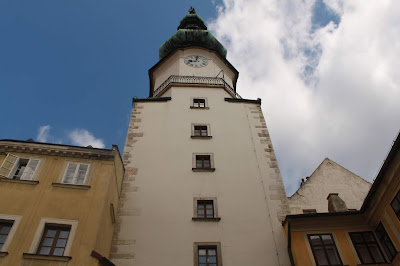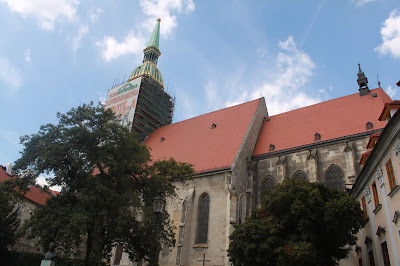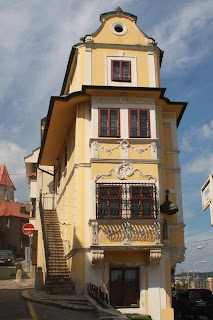In 2011, my then fiance and I spent close to a week in Vienna. I had planned a trip for the 20th anniversary reunion of my batch in my former school, Vienna International School. We decided to go to Bratislava for a day. It's just about 80 km east of Vienna. We went by ferry along the River Danube, and it took just about an hour. It was a lovely day, with scenic views along the iconic river, and with the various sights of the beautiful medieval town of Bratislava.
Bratislava is the capital of the
Slovak Republic and has a population of over 430,000. The city is one of
Europe’s smaller capitals. It lies along the River Danube as well as the River
Morava, and is along the Austrian and Hungarian borders. It is in fact the only national capital that borders two sovereign states. Many travelers end up giving Bratislava a miss, instead preferring to visit three of Europe's grandest capitals that are near by - Vienna, Budapest and Prague. However, the town certainly has its undeniable charm and is well worth a visit.
 |
A view of Bratislava with the Danube, Bratislava Castle
and St Martin's Cathedral |
From the 1st to the 4th century AD, the region was under the
Romans, and it became a major centre for wine making for them. The Slavs came to the region in the
5th and 6th centuries. In the 7th century, the Slavs established Samo’s Empire when the Avars
attacked the region. Bratislava Castle was built in the 9th century. In the 10th century, the region – then known as Pressburg –
came under Hungarian rule. In the 16th century, Hungary was defeated by the Ottomans. The Ottomans besieged and caused
damage to Pressburg. In
1536, Pressburg
became the new capital of Hungary under the Habsburg Monarchy. The city became
a coronation town for Hungarian kings, and it became the most important city in
Hungary. After the reign of Maria Theresia
ended, her son Joseph II took over, and the city lost some of its prominence –
the crown jewels were taken to Vienna, and many central offices and nobility
shifted to Buda.
After World War I, Czechoslovakia was
formed in 1918, and Pressburg was incorporated into the new
nation, despite resistance from the local population. In 1919, Pressburg
became the capital of Slovakia and later that year, the name Bratislava was
adopted. Many Hungarians either fled or were expelled from the city. During
World War II, the Slovak government cooperated with the Nazis and deported
15,000 Jews to Nazi concentration camps. Bratislava was bombed by the Allies
and suffered damage in the war. In 1948, the Communist Party came to
power in Czechoslovakia, and Bratislava became a part of the Eastern Bloc. In
the late 1980’s, the city was one of the main centres for
the anti Communist Velvet Revolution. In 1993, Bratislava was declared the new
capital of the Slovak Republic, after it broke away from the Czech Republic.
The Old Town Hall
dates back to the 15th century and was created by connecting three town houses. It
features a tower built in 1370, which offers a great view of the old city from
the top. The Bratislava City Museum lies in the premises and has exhibits on
the city’s history, and torture devices. The vibrant and lively Main
Square lies next to the Old
Town Hall. The square has the Maximilian Fountain, dating back to 1572. The
fountain shows Roland, a medieval knight, surveying the square.
 |
| Old Town Hall |
 |
| Archives, Bratislava City Museum |
 |
| Chapel, Bratislava City Museum |
 |
| Main Square |
Bratislava Castle lies on a hill above the town, overlooking the Danube. It goes
back to the 9th century. It was rebuilt in the 15th century. In 1811, it
burned down and was rebuilt in the 1950’s. Inside, there are several museums,
showcasing furniture, clocks, artefacts and musical instruments.
 |
| Bratislava Castle |
 |
| Gate, Bratislava Castle |
Bratislava is famous for some of its bronze statues scattered across the town centre. The Man
at Work Statue
was built in 1997. It is a bronze statue showing a sewer worker peeping at
passersby from a manhole. The Napoleon’s
Army Soldier Statue
lies close to the Main Square and has a statue of a soldier behind a bench. It’s a popular
photo op location for tourists.
 |
| Man at Work Statue |
 |
| Napoleon's Army Soldier Statue |
St Michael’s Gate is the only surviving gateway into the medieval city. It was
built in the 14th century. The Gothic tower was raised to its current height of
51 meters in the 18th century. There is a statue of the Archangel Michael at the
top. The tower has the Museum of Weapons and Town Fortifications. The tower has a terrace with a great view of
the city.
 |
| St Michael's Gate |
St Martin’s Cathedral was built in 1452. Between 1563 and 1830, 11 Hungarian kings
and 8 queens were crowned here. The church was refurbished in the 19th century. The tower stands at a height of 85 meters. The cathedral has a well
known sculpture of St Martin on horseback sharing his cloak with a beggar.
 |
| St Martin's Cathedral |
 |
Sculpture of St Martin,
St Martin's Cathedral |
 |
| Pulpit, St Martin's Cathedral |
Mirbach
Palace lies opposite the
Franciscan Church. The palace was completed in 1770 by a wealthy brewer. The
building’s last owner, Emil Mirbach, left the building
to the city. The palace houses an art gallery with 17th and 18th century baroque paintings.
 |
| Mirbach Palace |
 |
| Triton and Nymph Fountain, Mirbach Palace |
Primate’s Palace was built between 1778 and 1781. It was built for Jozef Batthyany, the primate of
Hungary and archbishop of Esztergom. It has a neo
classical pink and gold facade. At the top, there is the archbishop’s coat of
arms. The palace now has the office of the mayor. The palace has the Hall of
Mirrors, where the 1805 peace treaty was signed between Napoleon and Francis I.
 |
| Primate's Palace |
 |
| Courtyard, Primate's Palace |
Slovak
National Museum
opened in 1930. It is an important centre for scientific research and cultural
education. The museum also has a natural history section.
 |
| Slovak National Museum |
 |
| Giraffe, Slovak National Museum |
 |
| Shark, Slovak National Museum |
The Franciscan
Church dates back to the 13th century. During coronation ceremonies, the church was used for knighting of
those who proved themselves with their acts of bravery. The baroque interior
has furnishings from the 17th and 18th centuries.
 |
| Franciscan Church |
 |
| High Altar, Franciscan Church |
Jesuit Church is located next to the Old Town Hall. It was completed in 1638
as a protestant church.
 |
| Jesuit Church |
Blue
Church is officially named
the Church of St Elisabeth. The church was built between 1909 and 1913. It gets
the name Blue Church because of the colour of the facade and mosaics.
 |
| Blue Church |
House
of the Good Shepherd
was built between 1760 and 1765. It is a very narrow building, with just one
room on each floor. The building houses the Museum of Clocks, with clocks from
the 17th to
the 20th centuries.
 |
| House of the Good Shepherd |
Bratislava is compact enough for us to have covered most of its important sites in one day. It may not have the grandeur of Vienna, Budapest or Prague, but if one is in the region, it's certainly worth spending a day or two in. And the best way to visit the town is to go on the ferry along the Danube from Vienna!

























2 comments:
I met your late father in the mid-1980s when I was working for Government. He struck me as dignified and humane, besides being an officer with considerable administrative acumen.
Though I rarely read blogs, I liked yoursas it rang true for someone who lived abroad in similar circumstances for extended periods.
Debashish Chakravarti.
Dear Mr Chakravarti. Thank you for your kind comments.
Post a Comment